Drying laundry can be expensive! According to the U.S. Environmental Protection Agency, most households wash and dry up to 300 loads of laundry a year. What does that cost you in energy and money?
♦ A clothes dryer can consume over 4% of a home’s energy usage! (If you’re in the market for a clothes dryer, make it ENERGY STAR certified. Here’s the one that I got.)
♦ In addition to hiking up your energy bill, gas and electric clothes dryers add to your carbon footprint. Yes, your clothes get clean, but the planet gets a little bit dirty each time we turn the dryer on.
♦ Clothes dryers take a toll on the clothes themselves. Washing and drying adds to the wear and tear on fabric. Clothes may shrink if they’re subjected to hot temperatures. And who doesn’t hate the static cling that clothes get from spinning around in hot, dry air for an hour or so?
Here are six ways you can dry your clothes without using a lot of energy, racking up big bills, or wrecking your wardrobe. They still use natural resources to get the job done, but those resources — sunlight, and air — are completely free.
6 Better, Energy-Saving Ways to Dry Laundry
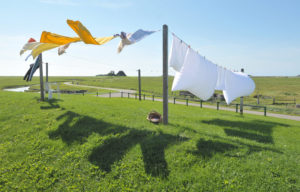

NOTE: Most lines stretch over time, so when you see yours drooping a bit, re-tie it on one end or the other.
While some community Home Owners Associations have banned neighbors’ rights to dry their clothes on “unsightly” outdoor lines, a national movement is afoot to overturn these bans and promote line drying.
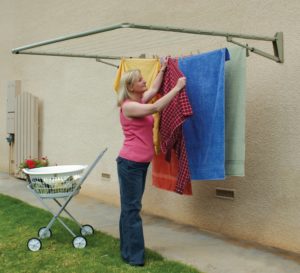
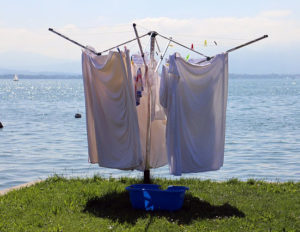
4) A retractable clothes line in your bathroom or laundry room. These lines can’t accommodate a lot of laundry at once, but they’re great for socks and underwear.
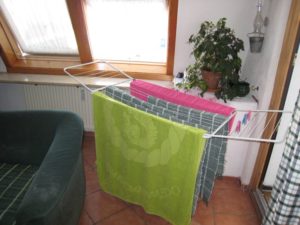
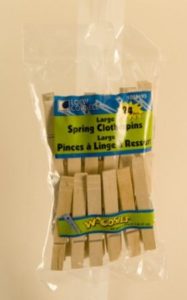
6) The Shower Stall – I regularly toss shirts, blouses, sweaters, pants and dresses over the top of my shower.
If you hang your laundry in the sun…
Stiff towels?
Line drying is terrific for sports wear, underwear, jeans, pants, towels, sheets, blouses, socks, and shirts. But towels? They can get a little stiff or crunchy when they line dry.
Some people find that adding white vinegar to the fabric softener dispenser helps soften their towels. I prefer to dry mine on the line almost completely, then toss them into the dryer to fluff up for ten minutes or so.
What about pet fur?
My throw rugs collect a LOT of fur from my dog and two cats. Tumble drying is still the most effective way to capture all that fur, even when I shake my rugs out before I wash them. I let the rugs dry almost completely outside, then tumble them for about 15 minutes to capture the fur. See what works best for you.
Final thought:
Dry drier clothes. The wetter your clothes are when you take them out of the washing machine, the longer it will take to dry them.
We use the highest spin cycle on our washer to get as much water out of our laundry as possible before we hang it up to dry or throw it in the dryer.
It shortens the drying time significantly, which saves us money.
RELATED


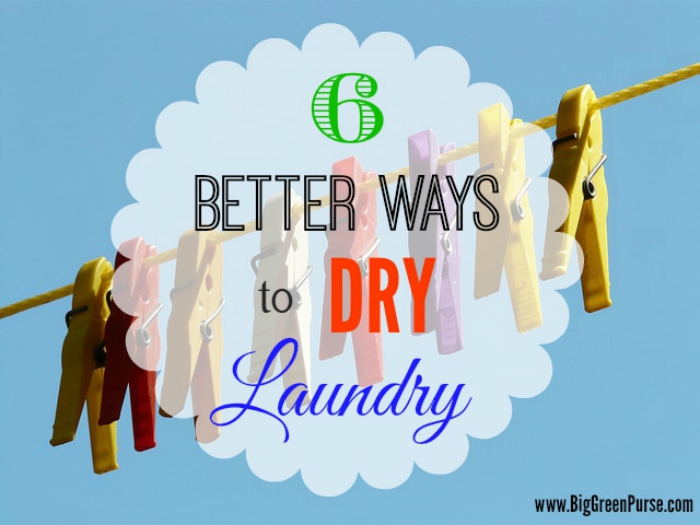




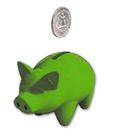









2 thoughts on “6 Better, Energy-Saving Ways to Dry Laundry”
Love all the different ways to dry your clothes. How do you deal with pollen in the Spring on the dried clothes?
Good question, Anna! There is probably a two-week period when the pollen is particularly heavy and I wouldn’t hang the clothes outside. Otherwise, I will shake them off once they’re dry and before I fold them. Also, I generally wash and dry clothes inside-out. Pollen isn’t “dirty” but it can leave a little dust if it’s not all shaken out. You never notice it once you turn the clothes right-side out again.
Comments are closed.